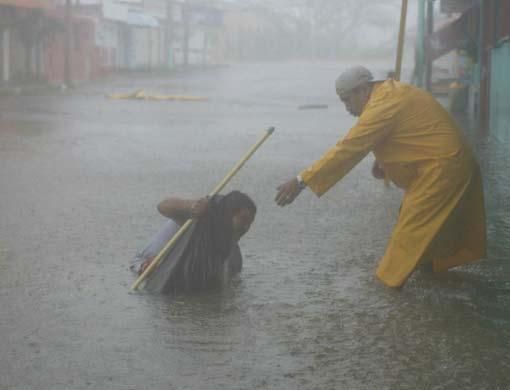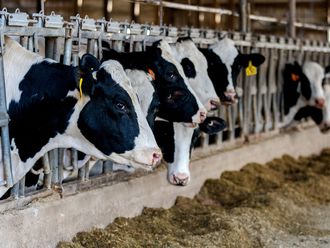Puerto, Mexico: Hurricane Dean crashed into the Caribbean coast of Mexico on Tuesday as the strongest hurricane to hit land in the Atlantic region since 1988. It lashed ancient Mayan ruins and headed for modern oil installations.
The eye of the storm hit land near Majahual, a port popular with cruise liners and it was racing across the Yucatan Peninsula towards an evening entry into the Bay of Campeche, where the state oil company had evacuated the oil rigs that produce most of Mexico's oil.
In the largely Mayan town of Felipe Carrillo Puerto, about 50km from the centre of the storm, people stared from their porches at broken tree limbs and electrical cables crisscrossing the streets, some of which were flooded with ankle-deep water.
Tin roofing ripped from houses clunked hollowly as it bounced in the still-strong winds that whistled through the town.
"We began to feel the strong winds about two in the morning and you could hear that the trees were breaking and some tin roofs were coming off," said 36-year-old store employee Miguel Colli. "Everyone holed up in their houses. Thank God that the worst is over."
Evacuation
Dean's initial blow was a stroke of luck for Mexico; it skirted most of the major tourist resorts, making landfall in a sparsely populated coastline. Governor Felix Gonzalex told Mexico's Televisa network that 250 small communities had been evacuated before it hit.
With the storm still screaming, there were no immediate reports of deaths, injuries or major damage, Gonzalez said, though officials had not been able to survey the area.
While the storm was weakening over land, the US National Hurricane Centre said it would likely still be a hurricane when it re-emerges over the Bay of Campeche and would gain force as it marches through the huge oil rigs that produce most of the nation's oil.
Petroleos Mexicanos evacuated all 18,000 offshore workers and shut down production rigs on the Bay of Campeche - resulting in a production loss of 2.7 million barrels of oil and 2.6 billion cubic feet of natural gas a day.
In Tulum, a beach town north of Dean's strike that is famed for its Mayan ruins, the storm bent palm trees and rattled tin roofing. Electricity was out, and residents huddled in the their homes as the wind moaned through the darkened streets.
At landfall, Dean had sustained winds near 270 km/h and still harder gusts. It knocked down trees and sent sheets of metal flying through the air in the Quintana Roo state capital, Chetumal.
The hurricane killed at least 12 people across the Caribbean, picked up strength after brushing Jamaica and the Cayman Islands and became a monstrous Category 5 hurricane on Monday.
Jamaica's Electoral Commission said yesterday it postponed the nation's Aug. 27 general elections until an assessment of damage from Hurricane Dean is completed. The storm caused extensive damage in eastern Jamaica and parts of the capital on Sunday.
Category 5 storms - capable of catastrophic damage - are extremely rare. Only three have hit the US since 1935.
Tens of thousands of tourists fled the beaches of the Mayan Riviera, though only the storm's weaker, outer bands hit it.
Dean's track would carry it into the central Mexican coast about 650km south of the Texas border, by today.
Yesterday, Dean threatened the Yucatan's most vulnerable population - the Mayan people - many of whom have seen little of the riches from oil or tourism.
Hurricane Dean third-most intense in Atlantic
Hurricane Dean was the third-most intense Atlantic hurricane to make landfall since record keeping began in the 1850s, based on its central atmospheric pressure, forecasters said.
The pressure in a hurricane's eye is often used to compare storms throughout history because in the past, wind gauges were often damaged or destroyed by powerful hurricanes.
Now, technology exists to more accurately measure winds, said Jamie Rhome, a hurricane specialist with the National Hurricane Centre. "And the damage is caused by the wind, so that's what most people look at," he said.
But pressure also measures strength: the lower the pressure, the greater a hurricane's power to suck in air. A hurricane's winds are blown because higher-pressure air rushes towards the lower-pressure eye.













